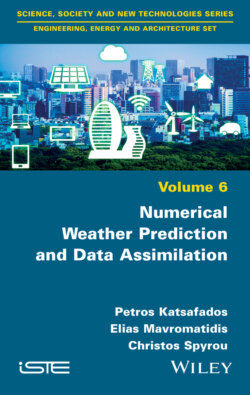Читать книгу Numerical Weather Prediction and Data Assimilation - Petros Katsafados - Страница 9
Оглавление
Preface
This book reflects the need to provide fundamental knowledge about theoretical and applied numerical weather prediction (NWP) and data assimilation (DA). It has been written to support undergraduates and graduates in atmospheric or Earth sciences and introduce students to elementary atmospheric dynamics and modeling, finite difference methods, numerical parameterizations, and optimization methods. This book has a more introductory and applied approach to the methods and techniques for NWP. It also includes essential materials for meteorological DA and modeling of the desert dust cycle in the atmospheric environment. Emission patterns, advection methods and deposition processes are all deployed in the chapter describing the desert dust cycle. The final chapter consists of real case studies simulating extreme weather events and a dust outbreak in hindcasting, nowcasting and forecasting modes.
This book is divided into six main chapters and two appendices. Apart from a brief introduction to NWP and DA in the Introduction, the theoretical material is covered in Chapters 1–4. The primitive equations governing the main atmospheric motions are analytically presented in Chapter 1, and the methods of solutions and finite difference schemes are included in Chapter 2. The implementation of the primitive equations on grid structures with boundary condition treatment is presented in Chapter 3. DA including successive correction methods and the variational approach with simple examples are introduced in Chapter 4. Chapter 5 is devoted to the analysis and modeling of desert dust processes, as well as a review of the parameterizations of dust feedbacks on climate. Finally, the simulations of three extreme weather events and a desert dust outbreak are presented in Chapter 6. The cases have been chosen as paradigms of phenomena on different time and spatial scales and to explore how such processes are eventually resolved in an atmospheric simulation. The appendices are presented at the end of this book, which include the basics of vector analysis and transformations into a rotating coordinate system, as well as turbulent diffusion and planetary boundary layer parameterizations.
Acknowledgments: We are indebted to a number of colleagues and PhD candidates for their contributions during the preparation of this book. Dr. George Varlas, Ms. E. Papadopoulou, Ms. V. M. Nomikou and Ms. A. Pappa are all acknowledged for their contributions to performing a part of the embedded simulations and results analysis. The European Centre for Medium Range Weather Forecasts (ECMWF), the National Center for Environmental Predictions (NCEP) and the National Oceanic and Atmospheric Administration (NOAA) are acknowledged for providing gridded analyses and climatologies, as well as surface observational data. The National Center for Atmospheric Research (NCAR) and the University Corporation for Atmospheric Research (UCAR) are also acknowledged for making available to us the Community Atmosphere Model version 3 (CAM3) and the Weather Research and Forecasting (WRF) model. Finally, we are grateful to the Hellenic National Meteorological Service (HNMS) and the National Observatory of Athens (NOA) for providing the precipitation measurements used in the case study of nowcasting in Chapter 6.
Petros KATSAFADOS
Elias MAVROMATIDIS
Christos SPYROU
February 2020
